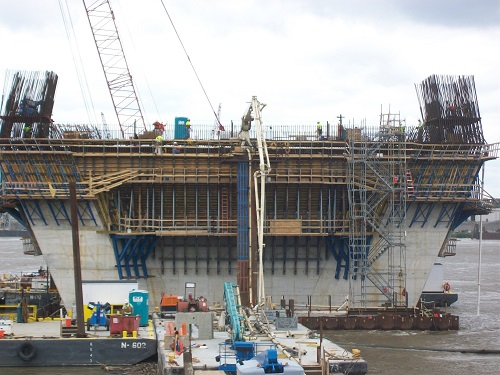The Illinois Department of Transportation will tell you that scuba gear is not standard equipment for bridge inspections. However, as federal mandate requires bridges crossing more than 20 feet of water to undergo underwater inspection every five years, the agency keeps a team of specially-trained scuba divers at the ready.
[Above photo by the Illinois DOT]
Those divers, many of whom are engineers Illinois DOT has contracts with, regularly explore the watery depths surrounding select bridge footings to primarily check for “scouring;” a leading cause of bridge failure. Scouring is soil erosion surrounding bridge foundation elements such as pier footings, columns, piling and abutments.
Divers typically conduct routine inspections in the fall when water levels are at their lowest, comparing ground-line elevations to previously recorded ones.
Low visibility poses a particular challenge, Illinois DOT noted in a blog post, as few bodies of water in Illinois offer more than a couple of feet of visibility – even with the aid of lights.

Given the murky and dark conditions, inspections are typically tactile, with the diver relying mainly on the sense of touch to detect potential defects, foundation exposure, undermining, and scouring.
If a structural- or safety-related deficiency is discovered – one that could pose a threat to the traveling public – Illinois DOT puts its “Critical Finding Procedures” into play.
In such situations, inspectors would immediately contact the Bureau of Bridges and Structures – as well as the appropriate bridge program manager – to discuss the observations and develop an agreed-upon action plan. In the most serious situations, Illinois DOT said bridges will be closed with local or state police assistance. Thankfully, however, such situations are extremely rare.
Over the last several years, many state departments of transportation tested a range of new technologies for improving underwater bridge inspection techniques.
For example, in 2019, the Michigan Department of Transportation deployed four unmanned surface vessels or USVs equipped with sonar and a topside camera; a vessel allowing inspectors to take measurements and capture images while positioned safely on the shoreline.
Such USVs not only help improve efforts to detect streambed erosion and degradation around a bridge’s substructure, they also keep people out of harm’s way.
 States
States
Dina El-Tawansy Appointed Director of Caltrans
July 11, 2025 States
States

